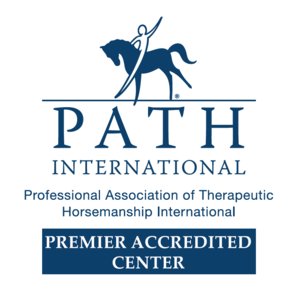Our Therapy Services:
Little Bit provides occupational, physical, and speech* therapy. A typical therapy session takes place on the back of the horse, in our on-site treatment room, and in the natural environment of the barn. Equine-assisted therapy is treatment that incorporates equine activities and/or the equine environment. Hippotherapy is a physical, occupational, and speech-language therapy treatment strategy that utilizes equine movement as part of an integrated intervention program to achieve functional outcomes.
In hippotherapy (HPOT, from the Greek "hippo" meaning "horse") the therapist uses the movement of the horse to address the patient’s challenges, such as deficits in balance, strength, endurance, coordination, communication, and attention. This therapy does not teach riding skills; rather the goals are geared towards independence with activities of daily living and increased participation in family, school and community life.
How does the horse’s movement help?
The movement of the horse creates a multi-sensory experience that is controlled by a skilled horse handler under the direction of the therapist. The three-dimensional movement imparted to the patient from the horse's movement creates a pattern that is similar to normal walking in the patient. This movement cannot be duplicated in traditional clinical settings. As a result of the horse's movement, the patient makes improvements with balance, strength, coordination, and postural control. In addition, the horse’s rhythmic movement and patient’s position on the horse can be changed, to provide specific and regulating input to balance, hearing, visual, skin and joint sensory receptors. Once regulated, patients are able to interact with their environment and have improved shared attention and communication.
Improvements in all of these areas can result in increased independence with activities such as walking, dressing and playing.
How do the different therapy disciplines use hippotherapy?
Physical Therapy
The physical therapist can overlay a variety of motor tasks on the horse’s movement to address the motor needs of each patient and to promote functional outcomes in skill areas related to gross motor ability such as sitting, standing, and walking.
Occupational Therapy
The occupational therapist is able to combine the effects of the equine movement with other standard intervention strategies to work on fine motor control, sensory integration, feeding skills, play skills, attention and self-regulation skills, and functional daily living skills in a progressively challenging manner.
Speech Therapy
The speech-language pathologist utilizes the movement of the horse to facilitate improved respiratory function, breath control, and oral-motor function. These effects are combined with standard speech and language intervention techniques to target articulation, fluency, and auditory processing. Using the natural environment, the therapist also addresses expressive language, receptive language, and social pragmatics.
H.E.R.D. (Horses Empowering Relationship Dynamics)
Little Bit is proud to offer “The H.E.R.D”! H.E.R.D (Horses Empowering Relationship Dynamics) is a therapeutic social group run by either an occupational therapist or speech therapist with a focus on building social emotional skills through horsemanship. Each group uses the equine environment to reinforce learning of concepts such as:
Learning about our own sensory systems including learning about individual needs, recognizing the needs of others, and learning strategies to get our needs met.
Navigating social communication including learning about communication differences, communicating with friends, and tuning in to others’ feelings, nurturing neurodiversity, and celebrating our own strengths!
Each group is tailored to the needs of the individuals in the unique group. Current groups forming for Fall 2025 include:
SLP Led group for ages 18+; Tuesdays from 5-6 pm
OT Led group for ages 7-10; Thursdays from 4:30-5:30 pm
H.E.R.D Group is best for individuals who can participate in a group setting (like a summer camp, or dance class) without 1:1 support. The SLP and/or OT are supported by trained volunteers; however, 1:1 support is not available at this time.
Please contact Lisa Spann if you have any questions, or if you would like to sign up today, please click/tap the button below and complete our intake questionnaire.
Email: LisaS@littlebit.org phone: (425) 882-1554






